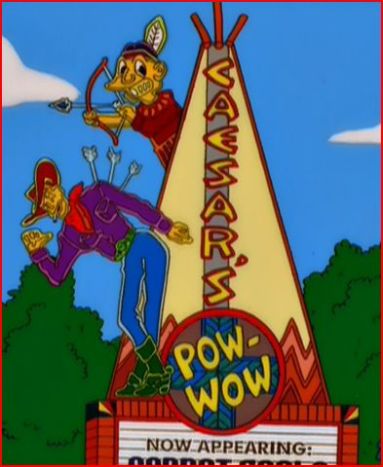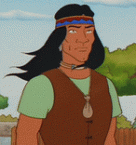As we’ve seen, there is an extreme lack of diversity in the portrayal of Native Americans in today’s popular media, especially in popular adult cartoons. An article entitled, “High Stakes Stereotypes: The Emergence of the ‘‘Casino Indian’’ Trope in Television Depictions of Contemporary Native Americans” talks about this tendency towards showing a certain type of Native American, specifically the “Casino Indian” stereotype. In two of my prominent examples provided below, this stereotype can be found without difficulty.
The author of this article, Celeste Lacroix, claims that the depictions of Native Americans in contemporary contexts reference age-old racist stereotypes of the Ignoble Savage while, at the same time, creating a new stereotype that she deems as the Casino Indian. Lacroix thus looked at six different television shows that can still be accessed today, which allows for their continued circulation in the media. All of these shows that are explored depict the “Casino Indian” stereotype in some fashion that draw upon age-old stereotypes that are harmful to the perception of this ethnic group. She attempts to expose this “new and more virulent form of racism that is reflected in the media stereotype of the ‘Casino Indian’”.
To begin, Lacroix explains the history of the portrayal of Native American’s in American media and literature and states that there is a dualism in the main depictions of stereotypes. That is, historically, Native Americans are portrayed as either a Noble Savage or an Ignoble Savage. Lacroix argues that this new stereotype of the “Casino Indian” draws upon the notions of the Ignoble Savage, specifically the “dangerous savage” and the “degraded Indian” stereotype. These two variants can be seen across the board in a staggering number of film and television portrayals of Native American’s, especially the men. However, Native American women are not immune to these various harmful stereotypes that can be seen in so many media outlets. The article continues on to state that in terms of the “degraded Indian” stereotype, women are called “squaw” to describe the lazy, drunken, and faceless females so often found in media portrayals.
In Lacroix’s analysis of six episodes, she provides several examples which evaluates the “characters’ vocabulary/speech, costuming, portrayed intelligence, anachronistic positioning, as well as the overall tone of each depiction.” She then continues on to argue how these presentations of the Casino Indian are reminiscent of the age-old negative stereotype of the Ignoble Savage.
This article concludes with three main themes that emerged with this critique of the new stereotype of the “Casino Indian”. The first theme was “Casino Indians exploit their culture for profit” suggesting that they exaggerated their cultural traditions to further their financial gain. The second theme that was elaborated on was “Casino Indians are led by scheming, immoral chiefs” in which Native leaders are portrayed to be severely corrupted by money and power. Finally, the last theme Locroix found was “Casino Indians aren’t authentically Native American”. This theme suggests that certain individuals take advantage of the opportunities that being Native American give, specially building casinos on the reservation.
This study concludes that the narrow depictions of Native Americans and their relationship to the “Casino Indian” stereotype have led to the general notion that, “Native Americans have manipulated the system and cultural sympathy for their plight to gain access to unearned, and more importantly, illegitimate wealth”. Though some of these episodes could be argued to be satires, such as Family Guy or South Park, this article address this counterargument by stating “the satire here seems to be less about making fun of our culture as it is using racist stereotypes to make fun of Native Americans”. Lacroix continues to back up her statements by arguing that the audience is in a position to see the Native characters “as to be laughed ‘at’ in an unreflexive way since the depiction does not seem to be an ironic commentary on dominant racism against Natives.” Overall, the article concludes that this new depiction of the “Casino Indian” constructs Native Americans to be looked at as both degraded and a threat to the dominant group.

I do not own any rights to this photo. It is being used only for educational purposes and was retrieved from Google Images on Sunday, April 29th 2012.
Citation:
Lacroix, Celeste C. (2011). “High Stakes Stereotypes: The Emergence of the ‘‘Casino Indian’’ Trope in Television Depictions of Contemporary Native Americans.” Howard Journal of Communications 22.1




